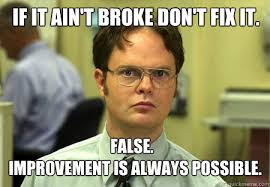Most often, the trigger for PDCA is when you come across a barrier or an issue within a process. The signal to step into action and begin PDCA is once your current state no longer reflects your trajectory to the desired target state. So, what happens when you reach your target state and there is nothing left to improve?
Trick question, there is ALWAYS something to improve! Recently within the Office of Continuous Improvement, we have been going through our own office standards and procedures. This week, during our second monthly office standard meeting we came up with a purpose statement for our meetings. One of the criteria for the purpose statement is that we needed to capture the importance of continuous improvement towards perfection, and not just the kind improvement that occurs after an issue is identified.
Currently, we’re reviewing the standards that we have found issues or road bumps with, in order to correct the issue as soon as possible. However, the monthly office standards meeting is also supposed to be a preemptive measure against road bumps for the future. Now that we’ve started to make improvement in the areas that need immediate attention, we will regularly check in and PDCA all of our processes.
Instead of waiting until something is wrong with a process before working on it, our goal is to continually improve each standard we have implemented. This way, instead of needing a trigger, it’s already part of our on-going process.
It may seem as though this is a waste of time, fixing something when it isn’t broke. However, we believe that taking the time to look over something before an issue arises, not only gives you more control over the situation, but it can also help alleviate any stress that often accompanies issues.
For example, let’s say that you regularly check the fluid levels of your vehicle. If you notice the break fluid is extremely low, you now have a hint that something is wrong and because you take the time to check your vehicle regularly, you very well have just avoided an accident. Would it have been a better use of time if you had just waited until the brakes light came on? Or perhaps if your brakes blew out on the highway?
In terms of safety and well-being, taking a few extra minutes here and there actually saves you time and stress later on, for your future self. That is the same with preemptive improvements. When you look ahead in anticipation of possible issues or areas of stress and take corrective measures beforehand, then you don’t have to deal with the crisis state. Overall, it’s helpful to remember that it’s important to look at what you may improve now, even though there may not be any foreseen issues yet. It’s not about what’s broken, but about whether or not there’s something that we can do to make sure it doesn’t break at all later, and in turn we get another step closer towards perfection in doing so.
